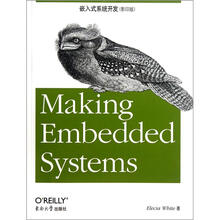嵌入式系统开发(影印版)

Preface
1. Introduction
Compilers, Languages, and Object-Oriented Programming
Embedded System Development
Debugging
More Challenges
Principles to Confront Those Challenges
Further Reading
2. Creating a System Architecture
Creating System Diagrams
The Block Diagram
Hierarchy of Control
Layered View
From Diagram to Architecture
Encapsulate Modules
Delegation of Tasks
Driver Interface: Open, Close, Read, Write, IOCTL
Adapter Pattern
Getting Started with Other Interfaces
Example: A Logging Interface
A Sandbox to Play In
Further Reading
3. Getting Your Hands on the Hardware
Hardware/Software Integration
Ideal Project Flow
Board Bring-Up
Reading a Datasheet
Datasheet Sections You Need When Things'Go Wrong
Important Text for Software Developers
Evaluating Components Using the Datasheet
Your Processor Is a Language
Reading a Schematic
Having a Debugging Toolbox (and a Fire Extinguisher)
Keep Your Board Safe
Toolbox
Digital Multimeter
Oscilloscopes and Logic Analyzers
Testing the Hardware (and Software)
Building Tests
Flash Test Example
Command and Response
Command Pattern
Dealing with Errors
Consistent Methodology
Error-Handling Library
Debugging Timing Errors
Further Reading
4. Outputs, Inputs, and Timers
Toggling an Output
Starting with Registers
Set the Pin to Be an Output
Turn On the LED
Blinking the LED
Troubleshooting
Separating the Hardware from the Action
Board-Specific Header File
I/O-Handling Code
Main Loop
Facade Pattern
The Input in I/O
A Simple Interface to a Button
Momentary Button Press
Interrupt on a Button Press
Configuring the Interrupt
Debouncing Switches
Runtime Uncertainty
Dependency Injection
Using a Timer
Timer Pieces
Doing the Math
A Long Wait Between Timer Ticks
Using the Timer
Using Pulse-Width Modulation
Shipping the Product
Further Reading
5. Managing the FIow 0fActiviB~
Scheduling and Operating System Basics
Tasks
Communication Between Tasks
Avoiding Race Conditions
Priority Inversion
State Machines
State Machine Example: Stoplight Controller
State-Centric State Machine
State-Centric State Machine with Hidden Transitions
Event-Centric State Machine
State Pattern
Table-Driven State Machine
Choosing a State Machine Implementation
Interrupts
An IRQ Happens
Save the Context
Get the ISR from the Vector Table
Calling the ISR
Restore the Context
When to Use Interrupts
How Not to Use Interrupts
Polling
System Tick
Time-Based Events
A Very Small Scheduler
Watchdog
Further Reading
6. Communicating with Peripherals
The Wide Reach of Peripherals
External Memory
Buttons and Key Matrices
Sensors
Actuators
Displays
So Many Ways of Communicating
Serial
Parallel
Ethernet and WiFi
Putting Peripherals and Communication Together
Data Handling
Adding Robustness to the Communication
Changing Data
Changing Algorithms
Further Reading
7. Updating Code
Onboard Bootloader
Build Your Own Updater
Modifying the Resident Updater
Brick Loader
Copy Loader to RAM
Run the Loader
Copy New Code to Scratch
Dangerous Time: Erase and Program
Reset to New Code
Security
Linker Scripts
Summary
8. Doing More with Less
Code Space
Reading a Map File (Part 1)
Process of Elimination
Libraries
Functions and Macros
Constants and Strings
RAM
Remove malloc
Reading a Map File (Part 2)
Registers and Local Variables
Function Chains
Pros and Cons of Globals
Memory Overlays
Speed
Profiling
Optimizing
Summary
Further Reading
9. Math
Identifying Fast and Slow Operations
Taking an Average
Use an Existing Algorithm
Designing and Modifying Algorithms
Factor Polynomials
Taylor Series
Dividing by a Constant
Scaling the Input
Lookup Tables
Fake Floating-Point Numbers
Rational Numbers
Precision
Addition (and Subtraction)
Multiplication (and Division)
Determining the Error
Further Reading
10. Reducing Power Consumption
Understanding Power Consumption
Turn Off the Light When You Leave the Room
Turn Off Peripherals
Turn Oft" Unused I/O devices
Turn Off Processor Subsystems
Slowing Down to Conserve Energy
Putting the Processor to Sleep
Interrupt-Based Code Flow Model
A Closer Look at the Main Loop
Processor Watchdog
Avoid Frequent Wake-Ups
Chained Processors
Further Reading
Index
1. Introduction
Compilers, Languages, and Object-Oriented Programming
Embedded System Development
Debugging
More Challenges
Principles to Confront Those Challenges
Further Reading
2. Creating a System Architecture
Creating System Diagrams
The Block Diagram
Hierarchy of Control
Layered View
From Diagram to Architecture
Encapsulate Modules
Delegation of Tasks
Driver Interface: Open, Close, Read, Write, IOCTL
Adapter Pattern
Getting Started with Other Interfaces
Example: A Logging Interface
A Sandbox to Play In
Further Reading
3. Getting Your Hands on the Hardware
Hardware/Software Integration
Ideal Project Flow
Board Bring-Up
Reading a Datasheet
Datasheet Sections You Need When Things'Go Wrong
Important Text for Software Developers
Evaluating Components Using the Datasheet
Your Processor Is a Language
Reading a Schematic
Having a Debugging Toolbox (and a Fire Extinguisher)
Keep Your Board Safe
Toolbox
Digital Multimeter
Oscilloscopes and Logic Analyzers
Testing the Hardware (and Software)
Building Tests
Flash Test Example
Command and Response
Command Pattern
Dealing with Errors
Consistent Methodology
Error-Handling Library
Debugging Timing Errors
Further Reading
4. Outputs, Inputs, and Timers
Toggling an Output
Starting with Registers
Set the Pin to Be an Output
Turn On the LED
Blinking the LED
Troubleshooting
Separating the Hardware from the Action
Board-Specific Header File
I/O-Handling Code
Main Loop
Facade Pattern
The Input in I/O
A Simple Interface to a Button
Momentary Button Press
Interrupt on a Button Press
Configuring the Interrupt
Debouncing Switches
Runtime Uncertainty
Dependency Injection
Using a Timer
Timer Pieces
Doing the Math
A Long Wait Between Timer Ticks
Using the Timer
Using Pulse-Width Modulation
Shipping the Product
Further Reading
5. Managing the FIow 0fActiviB~
Scheduling and Operating System Basics
Tasks
Communication Between Tasks
Avoiding Race Conditions
Priority Inversion
State Machines
State Machine Example: Stoplight Controller
State-Centric State Machine
State-Centric State Machine with Hidden Transitions
Event-Centric State Machine
State Pattern
Table-Driven State Machine
Choosing a State Machine Implementation
Interrupts
An IRQ Happens
Save the Context
Get the ISR from the Vector Table
Calling the ISR
Restore the Context
When to Use Interrupts
How Not to Use Interrupts
Polling
System Tick
Time-Based Events
A Very Small Scheduler
Watchdog
Further Reading
6. Communicating with Peripherals
The Wide Reach of Peripherals
External Memory
Buttons and Key Matrices
Sensors
Actuators
Displays
So Many Ways of Communicating
Serial
Parallel
Ethernet and WiFi
Putting Peripherals and Communication Together
Data Handling
Adding Robustness to the Communication
Changing Data
Changing Algorithms
Further Reading
7. Updating Code
Onboard Bootloader
Build Your Own Updater
Modifying the Resident Updater
Brick Loader
Copy Loader to RAM
Run the Loader
Copy New Code to Scratch
Dangerous Time: Erase and Program
Reset to New Code
Security
Linker Scripts
Summary
8. Doing More with Less
Code Space
Reading a Map File (Part 1)
Process of Elimination
Libraries
Functions and Macros
Constants and Strings
RAM
Remove malloc
Reading a Map File (Part 2)
Registers and Local Variables
Function Chains
Pros and Cons of Globals
Memory Overlays
Speed
Profiling
Optimizing
Summary
Further Reading
9. Math
Identifying Fast and Slow Operations
Taking an Average
Use an Existing Algorithm
Designing and Modifying Algorithms
Factor Polynomials
Taylor Series
Dividing by a Constant
Scaling the Input
Lookup Tables
Fake Floating-Point Numbers
Rational Numbers
Precision
Addition (and Subtraction)
Multiplication (and Division)
Determining the Error
Further Reading
10. Reducing Power Consumption
Understanding Power Consumption
Turn Off the Light When You Leave the Room
Turn Off Peripherals
Turn Oft" Unused I/O devices
Turn Off Processor Subsystems
Slowing Down to Conserve Energy
Putting the Processor to Sleep
Interrupt-Based Code Flow Model
A Closer Look at the Main Loop
Processor Watchdog
Avoid Frequent Wake-Ups
Chained Processors
Further Reading
Index
Elecia White是Logical Elegance,一家在圣何塞的嵌入式系统咨询公司的创办人。她喜欢制作有趣的玩意,包括医学设备、惯性测量装置、教育玩具和一套枪声定位系统。
《嵌入式系统开发(影印版)》特点:优化你的系统以减少损耗并增强性熊,开发一套能够让你的软件在资源有限的环境中稳定运行的架构,探讨传感器、电机和其他I/O设备,少花钱多办事:减少内存使用、编码空间、处理器周期和电量损耗学习如何在处理器中直接更新嵌入式代码,了解如何在小型处理器上实现复杂数学计算,当你寻求一份嵌入式系统工作时明白面试人员在说些什么。
比价列表价格走势
公众号、微信群
 缺书网
缺书网微信公众号
 扫码进群
扫码进群实时获取购书优惠







